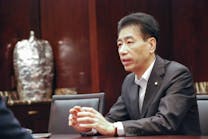A progress report on Yokogawa’s IA2IA journey
On the occasion of this week’s YNOW2024 conference in Houston, our own Keith Larson had a chance to sit down and connect with Mitsuhiro Yamamoto, vice president & executive officer of the Systems Business Division, Digital Solutions Headquarters, Yokogawa Electric Corp. Their conversation ranged from a historical perspective on Yokogawa’s distributed control systems (DCS) business to artificial intelligence, industrial autonomy and the impact of the Open Process Automation movement on the industry’s future. Read on for more of what was said.
Q: In line with this week’s theme of “Impact Your World,” what are the most important challenges Yokogawa is aiming to help address on behalf of its process industry users in the weeks and months ahead?
A: As an organization, Yokogawa defines our purpose in the world in terms of using our ability to measure and connect in order to fulfill our responsibilities for the future of the planet. Our ability to measure and connect is a core competence that Yokogawa must never lose. We wish to use this strength to find solutions to various social issues and create a future where humanity and planet Earth can co-exist in symbiotic harmony. This aspiration is expressed in our commitment to fulfill our responsibilities for the future of our planet.
Specifically, Yokogawa is aiming to help address social issues such as labor shortages and knowledge transfer due to the aging population as well as advancing sustainability, such as through higher efficiency energy consumption and a transition to renewable energy production.
Q: You’ve been in the DCS business almost as long as I’ve been covering them as a journalist. How have you seen the CENTUM DCS evolve over that time, and what sorts of new deliverables and platforms are now part of, or extensions of, the CENTUM range of capabilities?
A: I’ve been working in the process industry for more than 20 years now, and at the time I joined Yokogawa we were doing business mainly in Japan. But since then, we have seen significant growth overseas, especially in the oil and gas and petrochemical sectors. Further, we have focused on the completion of very large projects where we served as the main automation contractor, working with both end-users and engineering services firms. Our ability to complete large projects successfully has been possible because of tight collaboration among our product development and engineering teams, as well as adherence to high training standards among our engineers.
From a product perspective, Yokogawa’s CENTUM DCS has evolved in three areas:
- Operability improvement, through labor-saving measures such as effective alarm management and other advanced measures such as those based on ergonomic engineering.
- Connectivity improvement, through an expanded project execution scope, such as added capabilities for communication among subsystems.
- Engineering efficiency improvement, resulting in reduced engineering costs plus more timely and cost-effective project execution.
The DCS itself is also evolving from automation to autonomy. It is becoming more flexible through integration with our Collaborative Information Server (CI Server), our new platform designed to help realize IT/OT convergence. The CI Server runs complementary applications that are integrated with the DCS, such as our Robot Management Core application, for managing fleets of robots from diverse manufacturers. Further, the CI Server is home to AI applications that work together with the DCS.
Q: It’s going on five years now since Yokogawa coined the term IA2IA, for industry’s journey from Industrial Automation to Industrial Autonomy. Where do we stand on that journey today? What are the significant milestones of late?
A: Over the past several years there have been three notable milestones. These milestones have effectively transformed Yokogawa’s DCS from automation to autonomy. In a world’s first, Yokogawa’s AI autonomous control algorithm, based on factorial kernel dynamic policy programming (FKDPP) technology, was adopted for use at an ENEOS Materials Corp. chemical plant. One year of stable operation demonstrated this next-generation control technology can decrease environmental impact, achieve stable quality and transform operations.
Second, IT/OT convergence has been realized with the introduction of the CI Server, which has created an integrated operation environment that covers the entire plant or even multiple plants through a wide range of connectivity with Yokogawa and third-party control systems. This environment supports digital transformation into the OT domain by providing a platform for AI-based data analysis, abnormality prediction and decision support for operators.
The third milestone of note is the realization of single-user-interface operation for different robots from multiple suppliers, and the coordinated operation of the DCS with the robots. We envision a future where distributed controls and robots work together. For example, an alarm triggered by the DCS can be used to initiate a robot mission to inspect the site and address the problem. Also, data collected by the robot during its rounds of inspection can be reflected in DCS operations in real time.
Q: From my perspective, the concept of the digital twin is only now gathering speed, and full-fledged twins that reflect a physical asset’s capabilities and condition throughout its entire lifecycle will be increasingly commonplace. What role does the digital twin play in our IA2IA journey?
A: As you have indicated, we also believe that the digital twin will be able to reflect a physical asset’s capabilities and condition. In doing so, Yokogawa is advancing along three axes.
First, the digital twin can supplement information that cannot be measured in the physical plant. This includes “soft sensors” that do not perform physical measurements but can predict them based on other parameters. Applications range from quality stabilization by advanced control to the predictive diagnosis of catalyst conditions.
Second, the ability to generate future digital twin information from a time-series perspective makes it possible to take actions in advance against a future that may occur based on the extrapolation of current parameters into the future.
Third, the scope of the digital twin will expand from unit-level processes and asset twins to plant-wide twins and even twins that cover the entire supply chain. We believe it is no exaggeration to say that these digital twin advancements will lead to better learning for AI systems, which in turn will lead to Industrial Autonomy.
Q: The Open Process Automation, or OPA, movement has also gained significant momentum over the past several years, with real implementations beginning to take shape and delivering genuine benefits. How do you predict OPA will affect how dated systems are modernized? What about how new, grassroots projects are conceived and executed?
A: OPA aims to achieve the interoperability and portability of systems by standardizing communication methods and information models through the use of standard specifications. It provides process manufactures with further optimization of their plant operation management. Improved security is also a key benefit; OPA takes a “secure-by-design” approach and OPA components need to support IEC 62443-4-2 security level 2 (SL2) capabilities.
OPA will accelerate data utilization and IT/OT convergence by standardizing interfaces between system components. Further, it provides a pathway to modernize existing systems by extending the OPA system through gateways. And as for new, grassroots projects, OPA allows customers to select fit-for-purpose and best-in-class system components, while we aim to accelerate the automation of system configuration and providing services that save both money and time.
The O-PAS standard and the application of open technologies in process automation are still in their early stages. Moving forward, Yokogawa will support OPAF to evolve the O-PAS standard, build out the certification program, and help the industry adopt OPA by participating in OPAF and serving as an OPA System Integrator, Service Provider, and Component Supplier.
About the Author
Keith Larson
Group Publisher
Keith Larson is group publisher responsible for Endeavor Business Media's Industrial Processing group, including Automation World, Chemical Processing, Control, Control Design, Food Processing, Pharma Manufacturing, Plastics Machinery & Manufacturing, Processing and The Journal.

